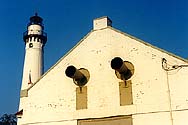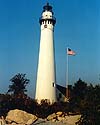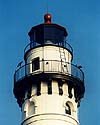 |
 |
 |
 |
| Wind Point Lighthouse | Seeing The Light |
|
|
|
|
Historical
Information
In 1900, to aid navigation during periods of low visibility, a fog signal was added. Steam powered, this signal could be heard from a distance of 40 miles out in the lake. Originally outfitted with a kerosene-fired Third Order Fresnel lens, the station was the second of all Great Lakes lights to be electrified in 1924
Since 1964, the village of Wind Point has leased the buildings and grounds from the Coast Guard, with the buildings used as offices. Spotlights illuminating the tower were installed in 1975, and though the lighthouse interior is not open to the public, the grounds are open during normal business hours, and thus one can obtain a close-up view of the station. Keepers of this
Light Seeing this
Light As we walked the property, we were pleasantly surprised to find the twin horns of the diaphone fog signal protruding from their original location in the signal building, making this one of the scant few lights we have visited with the horns still in place. One can only wonder if the rest of the apparatus is still in the building. Since the signal building windows were all boarded-over, we were unable to see inside to find out. The caretaker at this station obviously takes great pride in his work, since the station features a beautiful flower bed in front of the entrance, with a small pool and waterfall it's centerpiece. Unfortunately, we were at the light early in the morning, and we were unable to find the caretaker and ask if we could view the station's Third Order lens, which is supposedly displayed in the building. After photographing the light, we talk a short, but pleasant stroll along the beach. Unfortunately, our tight schedule would not allow us to stay as long as we would have liked. This is definitely a station that we plan to revisit! Finding this Light Contact
information Reference
Sources |
This page last modified 09/19/2005